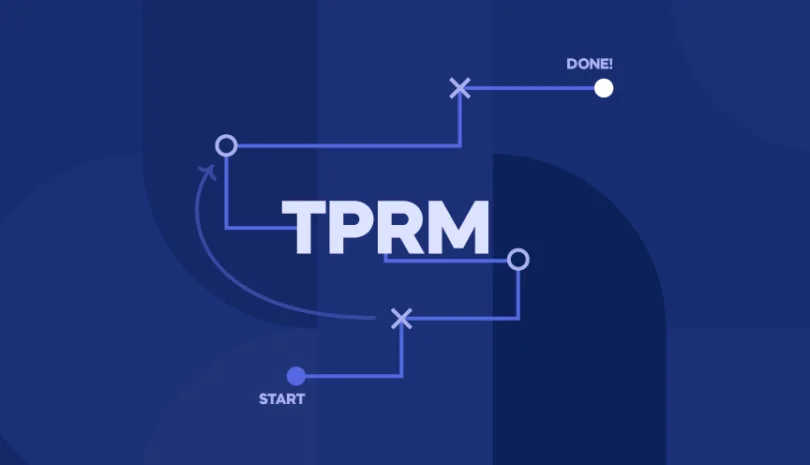State and local government agencies are increasingly reliant on third-party vendors to deliver critical services, from IT support and cloud infrastructure to managing public safety systems and citizen data. While these external partnerships are essential for smooth government operations, they introduce significant risks, especially as cyber threats and regulatory demands become more complex.
Third-Party Risk Management (TPRM) is the process of identifying, assessing, and managing risks associated with third-party vendors. For government agencies, TPRM is vital to ensure the security and compliance of sensitive data, safeguard public services, and avoid disruptions. Unlike in the private sector, state and local agencies face additional challenges, including budget constraints, legacy systems, and heightened public accountability. Given these unique circumstances, effectively implementing State & Local TPRM is crucial for maintaining operational continuity, meeting regulatory standards, and protecting public trust. In this post, we’ll break down the key components of State & Local TPRM and how agencies can successfully implement it to mitigate risks and enhance security.
What Is TPRM?
Third-Party Risk Management (TPRM) is the process by which organizations identify, assess, and manage risks posed by third-party vendors, contractors, and service providers. These risks can span various areas, including cybersecurity, data privacy, regulatory compliance, and operational continuity.
For state and local government agencies, TPRM is especially critical due to the sensitive nature of the data and systems they manage. Agencies handle citizen records, law enforcement data, and public safety systems, making them prime targets for cybercriminals and malicious actors. A breach or disruption in these areas can have far-reaching consequences for public safety and trust.
TPRM in the public sector differs significantly from the private sector. Government agencies often face stricter compliance requirements, such as the Federal Information Security Modernization Act (FISMA), NIST cybersecurity frameworks, and state-specific privacy laws like the California Consumer Privacy Act (CCPA). Moreover, public agencies are subject to higher levels of public accountability and transparency, which adds complexity to risk management efforts. These factors require a tailored approach to TPRM that takes into account the unique operational and regulatory landscape in which state and local governments operate.
The Unique TPRM Challenges of State & Local Agencies
State and local agencies face several unique challenges in managing third-party risk:
- Budget Constraints and Legacy Systems: Many agencies work with limited budgets and outdated legacy systems, which can hinder the implementation of modern TPRM practices. Updating infrastructure to address emerging risks becomes a challenge, leaving agencies vulnerable to new threats.
- Procurement Rules and Red Tape: Government procurement processes are often slow and complex, with layers of bureaucracy and regulations. This can delay the vendor onboarding process and complicate risk assessments, making it harder for agencies to act swiftly in managing third-party risks.
- Public Accountability and Transparency: Agencies must adhere to stringent public accountability standards, including disclosing certain contracts and risk assessments. This level of transparency can make it more difficult to navigate TPRM processes, as agencies must balance security needs with public disclosure requirements.
- Increased Targeting by Cybercriminals: Due to the sensitive nature of the data they handle, state and local governments are prime targets for cyberattacks. The reliance on third-party vendors for IT, cloud, and infrastructure services only amplifies these risks, requiring more robust and proactive TPRM strategies.
Why State & Local TPRM Matters
State and local TPRM is essential for several reasons:
- Data Sensitivity: Government agencies handle some of the most sensitive data, including citizen records, healthcare information, and law enforcement data. A data breach can have devastating consequences, ranging from legal ramifications to significant reputational damage. Protecting this data is paramount to maintaining public trust and ensuring privacy.
- Dependency on Third-Party Vendors: Agencies rely heavily on third-party vendors for vital services such as IT support, cloud infrastructure, and software solutions. These vendors often have access to sensitive government data, making them a potential weak point in the security chain. If a vendor’s system is compromised, it can result in widespread service disruptions and erode public confidence in the agency’s ability to protect its citizens’ information.
- Compliance with Frameworks: State and local agencies are bound by a variety of complex regulatory frameworks, including the NIST Cybersecurity Framework, state-specific privacy laws like the California Privacy Rights Act (CPRA), and the NY SHIELD Act. Failure to comply with these regulations can result in significant penalties, legal issues, and public distrust.
- Avoiding Service Disruption and Reputational Harm: Any disruption in government services, whether due to a cyberattack, vendor failure, or compliance violation, can have far-reaching effects. A comprehensive TPRM program helps prevent these disruptions, ensuring continuous operations and safeguarding the agency’s reputation.
Core Components of a State & Local TPRM Program
A comprehensive State & Local TPRM program includes several key components that work together to ensure third-party risks are identified, assessed, and managed effectively:
- Vendor Onboarding & Due Diligence: Before onboarding any vendor, it’s essential to conduct a thorough assessment to ensure they meet the agency’s security, compliance, and operational standards. This process helps verify that the vendor’s systems, policies, and practices align with the agency’s risk management framework and regulatory requirements.
- Contractual Safeguards: Contracts should be structured to protect both the agency and the vendor in the event of a breach or failure. Including cybersecurity clauses, service level agreements (SLAs), and confidentiality agreements is critical. These contractual provisions define expectations around data protection, incident response, and risk mitigation, ensuring both parties are aligned on their responsibilities.
- Risk Assessments: Ongoing risk assessments are vital to identify potential threats and vulnerabilities associated with third-party vendors. Initial assessments should be conducted before engaging a vendor, and periodic reassessments should be carried out to evaluate any changes in the vendor’s security posture, compliance status, or operational stability.
- Continuous Monitoring: Effective TPRM involves continuous monitoring of vendor cybersecurity practices. This includes tracking cyber risk ratings, vulnerability alerts, and security incidents to ensure any potential risks are detected in real-time and addressed before they escalate.
- Remediation & Reporting Workflows: Clear processes must be in place to respond to identified risks. This includes predefined remediation actions, reporting to relevant stakeholders, and documenting risk mitigation efforts. Timely response to risks is essential for minimizing potential damage and ensuring regulatory compliance.
- Cross-Agency Collaboration: TPRM should involve collaboration across departments (ex: IT, procurement, legal). This ensures a unified approach to risk management and strengthens the agency’s overall resilience against third-party risks.
How TPRM Platforms Can Help State and Local Governments
TPRM platforms provide a suite of tools designed to simplify, automate, and enhance the third-party risk management process for state and local governments. These platforms offer several key benefits that are essential for managing third-party risks effectively:
- Automate Assessments and Vendor Intake: TPRM platforms automate the vendor assessment process, significantly reducing the time and effort required for manual evaluations. Automated assessments ensure consistency, minimize human error, and streamline the intake of new vendors. By using pre-configured risk questionnaires and automated workflows, platforms enable agencies to efficiently gather necessary risk data and assess potential threats before onboarding vendors.
- Centralize Documentation and Workflows: Managing vendor risk documentation, contracts, and compliance records can be a complex and time-consuming task. TPRM platforms centralize this information, making it easier for agencies to track, manage, and update documents in real time. Centralized platforms provide a single repository for all vendor-related data, helping to ensure that critical information is always accessible and up to date.
- Offer Continuous Monitoring and Alerts: Continuous monitoring is vital for identifying risks that may arise after a vendor has been onboarded. TPRM platforms, like Panorays, provide ongoing monitoring of vendor cybersecurity practices and automatically generate alerts when potential risks, such as data breaches or vulnerabilities, are detected. This proactive approach enables agencies to respond quickly and prevent issues before they escalate.
- Ensure Compliance: Many TPRM platforms are designed to help state and local governments ensure compliance with complex regulatory requirements, such as NIST, FedRAMP, and state-specific laws. Platforms offer automated compliance tracking and reporting, helping agencies avoid penalties and maintain regulatory alignment.
- Enable Scalable Risk Governance: As government agencies grow and manage a larger number of vendors, TPRM platforms scale to meet their needs. These platforms support centralized risk governance across departments, allowing agencies to manage third-party risk at an enterprise level, regardless of their size or scope.
- Integration with Procurement and IT Systems: TPRM platforms integrate seamlessly with existing procurement and IT systems, streamlining workflows and reducing manual processes. Panorays helps create a more efficient, holistic approach to vendor risk management by allowing data to flow between systems without the need for duplicate entries or time-consuming manual updates.
What to Look for in a State and Local TPRM Platform
When selecting a TPRM platform, state and local government agencies should evaluate several critical factors to ensure they choose the right solution for their needs:
- Public-Sector Experience and Case Studies: It’s essential to choose a platform with proven experience working in the public sector. Look for platforms that have successfully helped other state and local agencies manage third-party risks. Case studies or customer references demonstrating success in navigating government-specific challenges, such as compliance with stringent regulations, can provide valuable insights into how the platform works in real-world scenarios.
- Support for Regulatory Mapping: A strong TPRM platform should support regulatory mapping for various compliance frameworks, such as NIST, FedRAMP, and state-specific privacy laws (e.g., CPRA, NY SHIELD). This functionality helps ensure that the platform can align with the agency’s legal and regulatory requirements, making compliance easier to manage and track.
- Customizable Workflows: Every state and local agency has unique procurement and risk management processes. A good TPRM platform should offer customizable workflows that can be tailored to fit these specific needs. This ensures that the platform supports the agency’s existing processes while improving efficiency and streamlining third-party risk management.
- Security and Compliance Certifications: Security and compliance are paramount when dealing with third-party risk. Agencies should choose platforms that hold recognized certifications, such as SOC 2 Type II or ISO 27001. These certifications demonstrate the platform’s commitment to maintaining high standards of security and compliance, ensuring that sensitive data is protected.
- Ease of Use: The platform should be intuitive and user-friendly, enabling easy adoption by multiple departments across the agency. A user-friendly interface ensures that all stakeholders, from procurement and legal teams to IT departments, can collaborate effectively on risk management efforts without extensive training.
- Budget-Friendly Options: Given budget constraints often faced by government agencies, it’s important to select a TPRM platform that offers cost-effective pricing options. Look for platforms that provide government pricing or budget-friendly plans that make it easier to implement TPRM without compromising on functionality.
Getting Started with State and Local TPRM
To successfully implement State and Local TPRM, agencies should begin by building internal awareness and securing executive buy-in. It’s crucial that key stakeholders across departments understand the importance of managing third-party risks and are committed to supporting the initiative. Executive backing will ensure the program receives the necessary resources and attention for success.
Next, agencies should audit their current third-party risk exposure. This involves identifying and assessing the risks associated with existing third-party vendors. A thorough audit helps prioritize areas of concern and sets a baseline for managing future risks effectively.
Establishing or updating TPRM policies is another important step. Agencies should develop clear policies that define how third-party risks will be managed. These policies should cover vendor selection criteria, risk assessment processes, compliance requirements, and incident response procedures to ensure consistency across departments.
Starting with critical vendors is essential. Focus initially on high-risk vendors that have significant access to sensitive data or systems. Once these vendors are properly managed, the agency can expand its efforts to include other vendors over time, ensuring comprehensive coverage.
Finally, consider a phased rollout when adopting a TPRM platform. This allows for smoother integration and adoption, helping agencies refine their processes and address challenges before scaling the program.
Empowering State & Local Agencies Through Smarter TPRM
Managing third-party risk is no longer optional for state and local government agencies, it is a vital component of safeguarding sensitive data, ensuring regulatory compliance, and maintaining public trust. As the threat landscape continues to evolve, so too must the approach to third-party risk management. With the right strategy, tools, and a scalable TPRM program, agencies can effectively mitigate risks, safeguard operations, and protect the citizens they serve.
By adopting smarter TPRM practices, state and local agencies can enhance their resilience to both cyber threats and operational disruptions. A well-structured TPRM program helps agencies not only manage the risks associated with third-party vendors but also stay ahead of regulatory requirements and compliance standards, ensuring that they remain in good standing with relevant laws and frameworks like NIST, FedRAMP, and state-specific privacy regulations.
Smarter TPRM tools, like those offered by Panorays, streamline processes, provide continuous monitoring, and deliver real-time alerts to help agencies stay proactive in risk management. This comprehensive approach to third-party risk enables agencies to mitigate potential threats before they escalate, ensuring smooth operations and a more secure future.
Book a personalized demo with Panorays today to see how our platform can help your agency manage third-party risk more effectively.
State and Local TPRM FAQs
-
TPRM is essential for government agencies because they are responsible for handling highly sensitive data, such as citizen records, law enforcement information, and public health data. Any breach or disruption in these areas can have severe consequences, including legal penalties, loss of public trust, and operational shutdowns. Effectively managing third-party risk ensures that these agencies protect sensitive data, maintain the continuity of vital public services, and meet regulatory requirements.
-
In the public sector, TPRM faces additional challenges due to complex regulations, heightened public accountability, and transparency requirements. Government agencies must comply with strict legal frameworks, ensuring that they protect citizens’ data while operating within the bounds of the law. Unlike private companies, public agencies also struggle with limited budgets and legacy systems, which can make implementing and maintaining TPRM programs more difficult. As a result, the public sector must adopt tailored approaches to third-party risk management that accommodate these unique challenges.
-
State and local agencies must ensure compliance with several regulatory frameworks, including the NIST Cybersecurity Framework, FedRAMP, the Criminal Justice Information Services (CJIS) Security Policy, and state-specific privacy laws like the California Privacy Rights Act (CPRA) and the New York SHIELD Act. Compliance with these regulations is critical for maintaining security and avoiding legal penalties.



